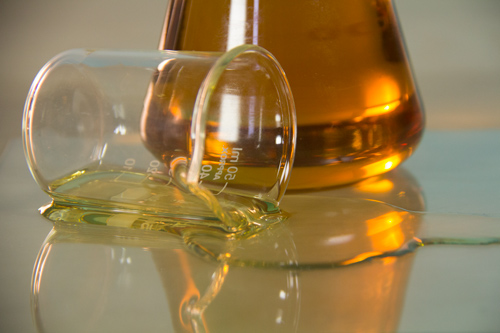Hydraulic Fluid
Table of Contents
| Spilled Fluid |
|---|
Characteristics of Hydraulic Fluid
Hydraulic systems move hydraulic fluid through the outlet from the reservoir by vacuums created by the pump. The components of hydraulic systems may operate at high temperature and speeds, therefore requiring hydraulic fluid to not only act as a method of power transfer but also as both a lubricant and medium for heat transfer [1].
Power Transfer
Bulk Modulus
Good hydraulic fluids have low compressibility so that all the applied pressure can be transmitted to components as opposed to the fluid itself. The bulk modulus is a property of a fluid which describes volume change under an applied force. Bulk modulus is the reciprocal of compressibility with units of pressure, and the higher the value the more the fluid resists compression. Bulk modulus can be described by the following formula:
Where VO is the original volume, ΔP is the pressure change, and ΔV is the change in volume [1].
Bulk modulus can also be defined as the slope of the pressure-volume curve of a specific fluid, which may be defined by the secant bulk modulus, the product of the original volume and the slope of the line drawn from the origin to any point on the curve. The secant bulk modulus can be described by the following formula [2]:
The value of petroleum oil compressibility is often presumed to be 0.5% per 1000 psi pressure increase up to 4000 psi [1].
Temperature and Bulk modulus
Fluids increase in temperature as they are compressed, which in turn causes the fluid to expand. If the fluid is compressed slowly enough that all heat generated is able to dissipate then the bulk modulus found is considered to be the isothermal bulk modulus. When the fluid is compressed quickly than the resulting pressure is a result of both compression and thermal expansion alike, then the bulk modulus found is considered to be the adiabatic or isentropic bulk modulus. It is often most helpful to look at the isentropic secant modulus at a fixed pressure and temperature since most hydraulic applications involve quickly moving components. The isothermal secant bulk modulus may be estimated from the viscosity and density characteristics of the fluid [1].
Positional Accuracy and Load Cessation
Actuator cylinders have momentum when moving at a uniform velocity which must be absorbed when the valves controlling both up and downstream flow is closed. The bulk modulus determines the peak pressure downstream under the assumptions that the pressure rises linearly and that both the cylinder and hydraulic lines are rigid. Therefore, the less energy is absorbed and less overshoot occurs the stiffer the fluid is, for a specific maximum pressure [2].
Heat Transfer
Heat Generation
In addition to the heat produced by fluid compression mentioned above, heat can be generated as a function of other regular operations. Heat may be produced by friction between moving components of the pump in addition to friction between the fluid and the internal surfaces of the system. Heat can also be generated when the potential energy of pressurized fluid is dissipated. The specific heat and thermal conductivity of hydraulic oils is generally a fraction of that of water, making proper system cooler sizing of great importance. Standards for determining the properties of hydraulic fluids include ASTM D 2717, ASTM D D 2766, Test Method for Thermal Conductivity of Liquids, and Test Method for Specific Heat of Liquids and Solids [1].
Thermal Conductivity (Btu/h/ft2/F/Ft, 212°F) | Thermal Conductivity (W/m×K, 373K) | Specific Heat (BTU/lb°F, 68°F) | Specific Heat (J/kg×K, 293K) | |
|---|---|---|---|---|
Oil | 0.08 | 0.14 | 0.47 | 1966 |
Water | 0.39 | 0.67 | 1.0 | 41814 |
Lubrication
The lubricating properties of the hydraulic fluid contribute a great deal to the durability of the hydraulic system. This lubrication reduces friction which in turn reduces wear and internal temperatures. Lubrication is due to the hydrodynamic properties stemming from the physical properties of the fluid, the boundary lubrication from the fluid chemistry, and mixed-film lubrication. A Stribeck Curve of the coefficient of friction by Sommerfeld number is given below. Hydrodynamic lubrication is generally the most significant lubrication mechanism when moderate temperatures and loads are in play. It occurs when a fluid film forms between moving surfaces with enough pressure to separate them, as formed by the shape and relative movement of the surfaces. Viscosity is the dominant fluid property for hydrodynamic lubrication as it governs the lubricating film's thickness. Fluid thickness must fall between a specific set of values to maintain volumetric efficiency without causing wear due to a lack of flow. Normal fluid viscosity is in the range of 15-68mm2/s (centistokes) at 40°C. This leads to the creation of a temperature operating window (TOW) for a specific hydraulic fluid [1].
Stribeck Curve of the Coefficient of Friction by Sommerfeld Number | |
|---|---|
References
[1] G. Totten, S. Westbrook and R. Shah, Fuels and lubricants handbook. West Conshohocken, PA: American Society for Testing and Materials, 2003, pp. 353-360.
[2] H. George and A. Barber, "Bulk Modulus: What is it? When is it Important?", Hydraulics & Pneumatics, 2007. [Online]. Available: https://www.hydraulicspneumatics.com/technologies/hydraulic-fluids/article/21885008/bulk-modulus-what-is-it-when-is-it-important. [Accessed: 26- Oct- 2020]
Contributors:
| User | Last Update |
|---|---|
| Mayurakhi Khan | 1189 days ago |
| Former user (Deleted) | 1383 days ago |
| Former user (Deleted) | 1427 days ago |
| Former user (Deleted) | 1518 days ago |
| Former user (Deleted) | 1545 days ago |


